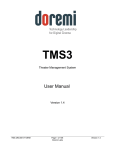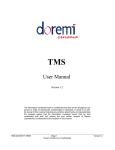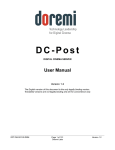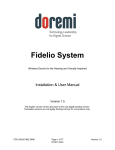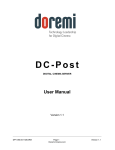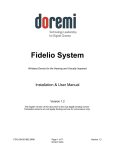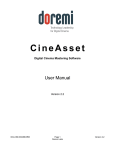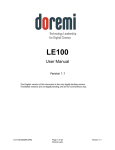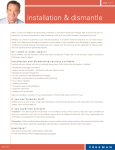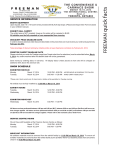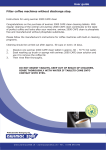Download TMS User Manual
Transcript
TMS Theater Management System User Manual Version 1.3 TMS.OM.000177.DRM Page 1 Doremi Cinema LLC Version 1.3 Table of Contents 1 Introduction....................................................................................................................................... 5 1.1 Purpose...................................................................................................................................... 5 1.2 Contact....................................................................................................................................... 5 2 GUI Overview.................................................................................................................................... 6 3 Quick Start Guide............................................................................................................................. 7 3.1 IP Setup...................................................................................................................................... 7 3.2 Logging In................................................................................................................................... 7 3.3 Screen Setting............................................................................................................................ 7 3.4 SPL Creation............................................................................................................................... 9 3.5 SPL Scheduling........................................................................................................................ 12 3.6 Uploading KDMs ...................................................................................................................... 14 3.7 Content Management............................................................................................................... 14 3.8 Logout....................................................................................................................................... 14 4 TMS GUI Tabs Description............................................................................................................. 15 4.1 Monitoring Tab.......................................................................................................................... 15 4.1.1 Presentation...................................................................................................................... 15 4.1.2 Screen Information............................................................................................................ 17 4.2 Scheduling Tab......................................................................................................................... 17 4.2.1 Standard Use..................................................................................................................... 17 4.2.1.1 Entry Description........................................................................................................18 4.2.2 Manager/Administrator Use...............................................................................................18 4.3 KDM Overview Tab...................................................................................................................21 4.4 Show Playlist Builder Tab.......................................................................................................... 23 4.4.1 Tab Overview.................................................................................................................... 23 4.4.2 Colors............................................................................................................................... 24 4.4.3 Show Playlist Creation......................................................................................................24 4.4.3.1 Principle..................................................................................................................... 24 4.4.3.2 Element Types........................................................................................................... 28 4.4.3.2.1 Audio-Visual Content..........................................................................................28 4.4.3.2.2 Automation Cues................................................................................................29 4.4.3.2.3 Trigger Cue.........................................................................................................30 4.4.3.2.4 Element Recording.............................................................................................32 4.4.3.2.5 Refresh Buttons..................................................................................................33 4.4.3.3 Properties Button.......................................................................................................33 4.4.3.4 Show Playlist Saving..................................................................................................34 4.4.3.5 New Show Playlist.....................................................................................................36 4.4.4 Show Playlist Opening.......................................................................................................36 4.4.5 Deletion Operations........................................................................................................... 36 4.5 Screen Management Tab.......................................................................................................... 39 4.5.1 Tab Overview..................................................................................................................... 39 TMS.OM.000177.DRM Page 2 Doremi Cinema LLC Version 1.3 4.5.1.1 Playback Tab............................................................................................................. 39 4.5.2 Applying Manager/Administrator Accounts........................................................................40 4.5.2.1 Pause Mode............................................................................................................... 41 4.5.2.2 Show Playlist Loading................................................................................................42 4.5.2.3 CPL and SPL Management.......................................................................................42 4.5.2.3.1 CPL Icons........................................................................................................... 44 4.5.2.4 Control Tab................................................................................................................ 45 4.6 Content Management Tab.........................................................................................................46 4.6.1 Ingest Progress Tab........................................................................................................... 46 4.6.2 Logs Tab............................................................................................................................ 47 4.7 Control Panel Tab..................................................................................................................... 48 4.7.1 Tab Overview..................................................................................................................... 48 4.7.2 User Management............................................................................................................. 49 4.7.2.1 Administrator User Rights..........................................................................................50 4.7.2.2 Manager User Rights.................................................................................................50 4.7.2.3 Simple User Rights....................................................................................................51 4.7.3 Servers ............................................................................................................................. 51 4.7.4 POS File............................................................................................................................ 52 4.7.5 Ingest................................................................................................................................. 53 4.7.5.1 Monitor Tab................................................................................................................54 4.7.5.2 Satellite Ingest ..........................................................................................................54 4.7.6 Disk Cleanup .................................................................................................................... 55 4.7.7 Log Report Generation.....................................................................................................56 4.7.8 Multiplex Macro Execution.................................................................................................57 5 LMS Control Panel......................................................................................................................... 58 5.1 Account Manager...................................................................................................................... 58 5.2 Applications Configuration........................................................................................................ 60 5.2.1 Log Retriever..................................................................................................................... 61 5.3 Date Configuration.................................................................................................................... 61 5.4 Display Configuration ............................................................................................................... 62 5.5 Log Manager............................................................................................................................. 62 5.6 Macro Execution....................................................................................................................... 63 5.7 Netmap Editor........................................................................................................................... 63 5.8 Networking Configuration.......................................................................................................... 64 5.9 Remote Shutdown ................................................................................................................... 65 6 Acronyms........................................................................................................................................ 66 7 Document Revision History........................................................................................................... 67 TMS.OM.000177.DRM Page 3 Doremi Cinema LLC Version 1.3 Software License Agreement The software license agreement can be found at the following location: http://www.doremilabs.com/support/cinema-support/cinema-warranties/ Hardware Warranty The hardware warranty can be found at the following location: http://www.doremilabs.com/support/cinema-support/cinema-warranties/ TMS.OM.000177.DRM Page 4 Doremi Cinema LLC Version 1.3 1 Introduction 1.1 Purpose The purpose of this user manual is to provide guidance on how to use the Doremi Theater Management System (TMS) application version 1.4.x. The TMS is based on a graphical user interface (GUI) and allows the user to manage several servers connected to a common network. 1.2 Contact If in need of help or assistance, please contact Doremi Labs Technical Support at: USA • 24/7 Technical Support line: + 1-866-484-4004 • Technical Support Email: [email protected] Europe • 24/7 Technical Support line: + 33 (0) 492-952-847 • Technical Support Link: http://support.doremitechno.org/ticketing Japan • Technical Support line: + 044-966-4855 • Technical Support Email: [email protected] Australia ~ China ~ India ~ Indonesia ~ Korea ~ Malaysia ~ New Zealand ~ Philippines ~ Singapore ~ Taiwan ~ Thailand • Technical Support Email: [email protected] TMS.OM.000177.DRM Page 5 Doremi Cinema LLC Version 1.3 2 GUI Overview The TMS GUI will automatically launch when logged in as doremi. • To launch the TMS GUI manually, go to the Start → Doremi Apps. → Theater Management menu. • The Doremi TMS GUI will appear showing the Monitoring tab as presented below (Figure 1): Backward and Forward Buttons Date and Disk Space • Figure 1: TMS GUI - Monitoring Tab The TMS GUI is composed of a set of tabs that allow access to all available functions of the TMS. The tabs are listed below: ◦ Monitoring ◦ Scheduling ◦ KDM Overview ◦ Show Playlist Builder ◦ Screen Management ◦ Content Management • • ◦ Control Panel The two buttons on the top right corner with left and right arrow icons are backward and forward functions. They allow the user to go back to the recently viewed tab (Figure 1). The bottom of the frame will display the complete date at the right corner and the total disk space and available free space of the LMS. The font color will change to indicate the available free space. A yellow color represents 10-20% and red color represents below 10% of total available free disk space (Figure 1). TMS.OM.000177.DRM Page 6 Doremi Cinema LLC Version 1.3 3 Quick Start Guide This quick start guide provides guidance on how to use the TMS GUI in order to configure screens, create and schedule SPLs, check associated KDM availability, and manage the associated content ingest processes. 3.1 IP Setup The Networking Configuration feature allows the user to set the network parameters. To access the Networking Configuration feature, go to Menu → LMS Control Panel → Networking Configuration. In the Devices tab of the window that appears, double click on the Ethernet port that you wish to configure. Fill out the fields on the window that appears with the help of your IT administrator. 3.2 Logging In To be able to configure screens, the user needs to be logged in as admin. • Go to the Control Panel tab and click on the User icon. • The following window will appear (Figure 2): Figure 2: Authentication Window • Select admin in the User name field. • Enter the admin password in the password field. ◦ Doremi Labs, Inc. has the default password. • Click on OK. • The user is now logged in as admin. 3.3 Screen Setting • To perform the set up of the screens, click on the Servers icon in the Control Panel tab. • The Server Edit screen will appear allowing the user to configure the screens in the appropriate manner ( Figure 3). TMS.OM.000177.DRM Page 7 Doremi Cinema LLC Version 1.3 Add Server Button Remove Server Button Scan Network Button Management IP Server IP Figure 3: Add Server GUI • To add a server, click on the Add Server button. • To remove a server, select it and click on the Remove Server button. • To scan for available servers, click on the Scan Network button. ◦ The Network Scan window will appear. ◦ Select one or more servers to add and then Click OK to add. Figure 4: Scan Network Window TMS.OM.000177.DRM Page 8 Doremi Cinema LLC Version 1.3 • To manually add a server: ◦ Click on the Add Server button. ◦ Fill in the required information ( Figure 3). ▪ For screen servers, enter the auditorium number, usually between 1 and 32, and specify the type of playback (3D or 2D). ▪ The serial number field will be filled automatically once the Save button is clicked. ▪ Select the network server type and the file type. • Ingest server should only be selected for the LMS. ▪ Input the server IP and the management IP, with their respective usernames and passwords. ▪ Note: The server IP would typically use the “manager” login type and the management IP would typically use the “admin” login type. Note: If the LMS Library resides on the TMS server itself, then the IP addresses are the same as the TMS. The manager and admin account information has to match the account information on that particular screen server. • Click on Save when finished. 3.4 SPL Creation • If Show Playlists are complete, then skip this section and proceed to Section 3.5. • Creating a Show Playlist to be ingested on the screen: ◦ Go to the Show Playlist Builder tab. ◦ Click the New button followed by New Playlist. ◦ On the left part of the window, select the composition (CPL) items to add to the playlist. ◦ Select consecutive CPLs by using the shift key or use the "Ctrl" button to select multiple non-consecutive CPLs. ◦ Click on the Add to Show Playlist button to add all the selected CPLs to the SPL panel. ◦ The available content will appear. Note: If no composition is visible on the left part of the tab, click the Refresh button. ◦ The two arrow buttons allow the user to change the order of the CPLs in the Show Playlist panel. Refer to Section 4.4 for SPL creation details. • To add an automation cue to a CPL present in the Show Playlist: ◦ Select the desired CPL on the right part of the Show Playlist Builder window. ◦ Select the desired automation cue on the left part of the window. ◦ Click the Add to Show Playlist button. ◦ The user will be asked to define Automation Cue parameters. See Section 4.4.3.2.2 for detailed information. TMS.OM.000177.DRM Page 9 Doremi Cinema LLC Version 1.3 Note: Trigger Cues can be added to the Show Playlist. Refer to Section 4.4.3.2.3 for the related procedure. ◦ Save the Show Playlist when finished by clicking on the Save button on the top of the tab. ◦ If there is any content you wish to prevent from being deleted, click on the Edit Locking button, check the desired content, and click Save. • Creating a Show Playlist Pack: ◦ The TMS also allows the creation of re-usable playlist packs. Click on the New button in the show playlist builder; this will bring a pop-up menu with the option: New Playlist Pack. ◦ Click the Add Pack button. ◦ Enter a pack name or select among the pre-defined playlist packs (PRESHOS_PACK, TRAILER_PACK, FEATURE_PACK, or POSTSHOW_PACK, Figure 5). Figure 5: SPL Pack ◦ An item representing the name of the pack will be added and highlighted in green (Figure 6). TMS.OM.000177.DRM Page 10 Doremi Cinema LLC Version 1.3 Figure 6: SPL Pack Added ◦ Proceed by adding CPLs, automation cues and trigger cues. ◦ Save the Show Playlist Pack when finished by clicking on the Save button on the top of the tab. ◦ Once saved, the SPL pack will show, in purple, in the left panel, under Playlist Packs. The playlist packs can then be added to another SPL like any other CPL or cue item (Figure 7). TMS.OM.000177.DRM Page 11 Doremi Cinema LLC Version 1.3 Figure 7: SPL Packs Added 3.5 SPL Scheduling To schedule a Show Playlist playback, follow the steps below: • Go to the Scheduling tab. See Section 4.2 for additional guidance about this tab. • Click on the Add Schedule button. • The following window will appear (Figure 8): TMS.OM.000177.DRM Page 12 Doremi Cinema LLC Version 1.3 Show Playlist listbox Date of Schedule Screen Number listbox Time of Schedule Figure 8: Add Schedule Window • Select the Show Playlist that needs to be scheduled within the Show Playlist box. • Choose the Screen Number and the date/time that is to be scheduled. • Click on the Add button when finished. • The new schedule will appear on the main window of the Scheduling tab. • If the SPL is not on the SMS, then the TMS will initiate the SPL transfer to the SMS. TMS.OM.000177.DRM Page 13 Doremi Cinema LLC Version 1.3 3.6 Uploading KDMs A Show Playlist might contain encrypted CPLs. To identify an encrypted CPL, look for the lock icon to the left of its name in the Show Playlist builder window ( ). Each encrypted CPL requires a valid KDM. If this is the case, make sure that a valid KDM exists for each encrypted CPL in order to be able to perform the playback. • Go to the KDM Overview tab. See Section 4.3 for additional guidance on this tab. • Check in the displayed list of available KDMs to see if there is one for each encrypted CPL in the Show Playlist. • If a KDM is missing, click on the KDM Upload button in order to upload it and then follow the steps. • Use the Browse button to select the proper KDM folder and upload the KDM (Figure 18). 3.7 Content Management The Content Management tab will display the status of all ingest jobs. It will show the progress of the current jobs and it will list all pending jobs. The TMS can execute transfers to four screens simultaneously. The Content Management tab will allow users to cancel a CPL or SPL transfer. 3.8 Logout To prevent unauthorized changes to settings and scheduling, click logout. • Go to the Control Panel tab and click on the User icon. • The following window will appear (Figure 9): Logout Button Figure 9: Authentication Window • Click on Logout. TMS.OM.000177.DRM Page 14 Doremi Cinema LLC Version 1.3 4 TMS GUI Tabs Description 4.1 Monitoring Tab • To enter the Monitoring tab, click on Monitoring on the top of the GUI. • The Monitoring window is composed of two different parts (Figure 10): 1. The top part lists all the screens added to the TMS together with their states: offline, online, and playing. 2. The bottom part displays information about the selected screens. 4.1.1 Presentation Screens are listed vertically under the screen column header. Each screen is identified with an icon displaying the screen number inside it. The icon's color and shape reflects the current status of the SMS. Below are the different icons used: • :Blue square indicates online and idle status. • :Green triangle indicates online and playing content. • :Red hexagon indicates offline. • :Orange square indicates that the media block is disconnected. • A smaller icon can appear next to the screen number when the available free space drops below a certain threshold. ◦ :A warning icon in yellow indicates that the configured warning threshold (11% - 20%) for the remaining free space was reached. ◦ :A critical icon in red indicates that the configured critical threshold (10% or less) for the remaining free space was reached. TMS.OM.000177.DRM Page 15 Doremi Cinema LLC Version 1.3 Monitoring Tab Arrow Icon Screen Icons SPL Name Clip Bar Content Type Screen Information Figure 10: TMS GUI - Monitoring Tab Note: The small warning/critical icon can be used to display some other warnings. Point the mouse over the screen icon to display the description of the errors or warnings. To the right of the screen icon, the following information is displayed only when the screen is in playback mode. 1. A Show Playlist name is displayed in conjunction with one or more bars beneath. The bars represent the different clips in the SPL. The short bar is for trailers and the long bar is for features. ◦ Hovering over the name will list the content in each SPL. ◦ The letters above the bars indicate what type of content the clip contains: ▪ FL= Flat ▪ SC= Scope ▪ HD= High Definition ▪ FU= Full ▪ PA= Pattern 2. Elapsed time. 3. Remaining time. 4. Next Show. 5. Projector. TMS.OM.000177.DRM Page 16 Doremi Cinema LLC Version 1.3 • The last two columns can appear and disappear by clicking on the Arrow icon. • To access the Screen Management tab associated with the selected screen, double-click on the screen icon and the GUI will display the Screen Management tab (Section 4.5). Using the mouse to hover over the SPL name or the clip bars will list the content found in the SPL. 4.1.2 Screen Information The bottom part will display information specific to the server on a particular screen (Figure 10). By selecting a screen on the top, the following information will be displayed: • 1) Server Serial Number. 2) Software and Firmware version. 3) Total disk space; used and free. The color of the free space will change if it drops below a certain threshold. The color yellow indicates a free space between 10% and 20%. The color red indicates free space below 10% of total disk space. 4.2 Scheduling Tab 4.2.1 Standard Use • • To enter the Scheduling tab, click on Scheduling on the top of the GUI at any time during the TMS GUI usage. The Scheduling tab is illustrated below (Figure 11): Edit Links Button Date Selection View Field Past Schedule Entry Previous and Next Button Refresh Button Scheduling Window Delete All Schedules Delete Schedule Add Schedule Figure 11: TMS GUI - Scheduling Tab TMS.OM.000177.DRM Page 17 Doremi Cinema LLC Version 1.3 • Edit Links button: This will link a specific movie name to an SPL. • Previous Day and Next Day button: These buttons will show the schedule by the selected view period. It can be daily, weekly, monthly, or yearly. • Date Selection field: This will allow the user to specify the starting day of the schedule. • Refresh button: This will refresh the scheduling window. • View field drop-down menu: This will specify the period to display in the scheduling window starting with the day specified in the date selection. • Delete Schedule button: This will delete the selected entry from the schedule. The selected entry will be deleted immediately without confirmation. • Delete All Schedules button: This will delete the entire schedule on both the TMS and the screens associated with the system. A confirmation is required in order for the operation to be completed. Only a manager login can execute this operation. The operation will delete the schedule only; no content will be lost in the process. • Add Schedule button: This will allow the user to manually schedule an SPL on a specific screen at a specific time and day. • The Scheduling window will list all the entries starting from the date in the Date Selection up to the period selected in the View drop-down menu. • Schedules that have already passed will be shown with the line highlighted in gray. 4.2.1.1 • Entry Description Each entry takes one line and is composed of four fields as listed below: ◦ Date and Time ◦ Screen Name ◦ Movie Name ◦ Notes • The font color will reflect the status of the entry. ◦ A black font is ready and the red font indicates an error. ◦ A gray font is for past entries. • The error type will be reflected in the notes. 4.2.2 Manager/Administrator Use If the user is logged in as either manager or admin, they will be able to modify the settings. In this tab, it corresponds to: • A schedule addition • Schedule(s) deletion • Links editing To add a schedule, click on Add Schedule: • The following window will appear (Figure 12): TMS.OM.000177.DRM Page 18 Doremi Cinema LLC Version 1.3 Figure 12: Add Schedule Window • To schedule a playback of a Show Playlist for a given auditorium and time, click on Add when finished. • The new schedule will appear in the schedule list. • Select the appropriate View mode from the drop-down menu. To delete an existing schedule, select it in the schedule list and click on Delete Schedule. • The schedule will disappear. • To delete all the schedules, click on the Delete All Schedules button. To link a movie listed in the POS file to a specific Show Playlist, click on the Edit Links button (Figure 13). Movies Window Show Playlists Window Linked Button All Button Unlinked Button Link Button Figure 13: Edit Links Window – Unlinked View • The left side provides the list of movies listed in the POS File. This largely depends on whether or not the Show Playlist is linked with the POS file. • If the Unlinked button is clicked, the Movies window will display the list of movies that are not linked to any Show Playlist. • Select one movie from the POS File and one from the Show Playlist and click on Link. TMS.OM.000177.DRM Page 19 Doremi Cinema LLC Version 1.3 • The Show Playlist will be linked to the movie title defined in the POS File. • The playback of the Show Playlist will be performed according to the schedule of the linked movies title defined in the POS File. • To view the movie titles already linked to Show Playlists, click on Linked on the bottom of the Edit Links window. • The following window will be displayed (Figure 14): Unlink Button • Figure 14: Edit Links Window – Linked View From this window, the user can select one title and unlink it by clicking on the Unlink button. • To view the whole list of movie titles listed in the POS file, whether they are linked or unlinked, click on All. • The Movies window will reflect the whole movie list, indicating the movie titles that are unlinked in red, as presented below (Figure 15): Unlinked POS Title Figure 15: Edit Links Window – Linked View TMS.OM.000177.DRM Page 20 Doremi Cinema LLC Version 1.3 4.3 KDM Overview Tab • To enter the KDM Overview tab, click on KDM Overview on the top of the GUI at any time during the TMS GUI usage. • The KDM Overview tab will display all the KDMs available on the network using a color code to indicate their validity. • Below are the color codes and their correspondences: ◦ A green line corresponds to a KDM valid for more than 48 hours. ◦ A yellow line corresponds to a KDM valid for less than 48 hours. ◦ A red line corresponds to a KDM that is not currently valid, but will be valid in the future. KDM Upload Legend Button Indicates which screen the KDM can be used on KDM Overview Tab Composition Play ListContent Title Delete Expired KDMs Button Delete KDMs Button • • Figure 16: KDM Overview Tab The first column indicates on which screen the KDM can be used, and the next columns indicate the Content Title of the corresponding Composition Playlist. It also indicates the start and end dates of the KDM validity window (Figure 16). The following color significance (Figure 17) is available by clicking the Legend button (Figure 16). Figure 17: KDM Highlight Window TMS.OM.000177.DRM Page 21 Doremi Cinema LLC Version 1.3 • To delete a KDM, select it in the KDM list and click the Delete KDM button (Figure 16). • To delete all expired KDMs, click the Delete Expired KDM button (Figure 16). • The KDMs Upload button (Figure 16) allows for ingestion of KDMs from the TMS (USB or local directory). Use the Browse button to select the folder from which to ingest the KDMs (Figure 18). Browse Button Upload All Button List of available KDMs in the selected folder Upload Selected Button Close Button Figure 18: KDM Upload Window • To upload one or more KDMs, select it and click the Upload Selected button. • To upload all KDMs, click the Upload All button. • Click the Close button to close the KDMs Upload window. Note: Right clicking on an Uploading of KDM line in the bottom part of the tab will show a menu to clear the status logs or delete the selected message (Figure 19). Figure 19: KDMs Upload Window – Right Click Menu TMS.OM.000177.DRM Page 22 Doremi Cinema LLC Version 1.3 4.4 Show Playlist Builder Tab 4.4.1 Tab Overview • To enter the Show Playlist Builder tab, click on Show Playlist Builder at any time during the TMS GUI usage (Figure 20). • The Show Playlist Builder tab contains: ◦ A left part with all the Digital Cinema Packages (DCP) that were found on the LMS: features, trailers, and advertisements. They are together with the available automation cues and trigger cues. The Whole Multiplex feature will show all the available DCPs found on one or more screens. All content that is shown in bold font exists on the LMS and on one or more screens. Content with a fine line does not exist on the LMS. ◦ A right part used to display the content of a given Show Playlist, that is already created or existing. A Show Playlist is described in the next step. Note: Content type is differentiated by color and font. Pointing to a certain content will make an informative tool-tip showing the format and location available (Figure 20). Whole Multiplex check-box Informative Tool Figure 20: Show Playlist Builder Tab TMS.OM.000177.DRM Page 23 Doremi Cinema LLC Version 1.3 4.4.2 Colors Different colors represent different formats in the Show Playlist Builder: • Flat: ◦ 2D is dark blue. ◦ 3D is light blue. • Scope: ◦ 2D is dark green. ◦ 3D is light green. • HD: ◦ 2D is dark brown. ◦ 3D is light brown/orange. • Full: ◦ 2D is dark red. ◦ 3D is light red. 4.4.3 Show Playlist Creation A Show Playlist defines a succession of DCPs and Automation Cues. It provides the events chain to be taken into account for the playback of a show. A Show Playlist can be newly created or an existing Show Playlist can be opened and edited. 4.4.3.1 Principle The Show Playlist Builder tab allows the users to create their own Show Playlist from the elements listed in the Contents window. • To add an element to the Show Playlist, select it. The element will be reverse highlighted. • There are two ways to find content in the tab. • To search for a specific CPL, click on the Find Content button (Figure 22) and type in the name of the CPL (Figure 21). Figure 21: Find Content Window • To filter the CPLs, click on the Filter button (Figure 22). The user can filter by advertisements, automation cues, features, patterns, playlist packs, policy, psa, rating, shorts, teasers, tests, trailers, transnational, trigger cues, and a custom search. TMS.OM.000177.DRM Page 24 Doremi Cinema LLC Version 1.3 Find Content Button Filter Button Sorting Option Drop-down List Figure 22: Find Content Options • There is also a Sorting Option drop-down list that allows the user to sort the content on the left side of the window by name, format, and locked material (Figure 22). See Section 4.4.5 for more information on locked material. • Click on the Add to Show Playlist button to add the highlighted CPL. • The element will appear on the right part of the window. Repeating this operation with all the required elements will lead to a Show Playlist (Figure 23): TMS.OM.000177.DRM Page 25 Doremi Cinema LLC Version 1.3 Ingest SPL Button SPL Properties Button Figure 23: Show Playlist Creation • If the user is trying to add content with different formats, the Dissimilar Content window will appear asking the user if they would like to continue. Click Add Anyway to add the content to the SPL regardless of its format. Figure 24: Dissimilar Content Window • If an element needs to be removed from the Show Playlist, select it in the Show Playlist window and click on Remove. • The Ingest SPL button (Figure 23) forces the SPL ingest on a selected screen right away. The SPL ingest window that will appear is presented below (Figure 25): TMS.OM.000177.DRM Page 26 Doremi Cinema LLC Version 1.3 Start Ingest Button Figure 25: Show Playlist Ingest Window • Select the SPL to ingest and the destination screen, then click on the Start Ingest button (Figure 25). • Clicking on the SPL Properties button (Figure 23) will make the SPL Properties window visible (Figure 26). Close Button Figure 26: SPL Properties Window • If necessary, change the name of the SPL and set to 3D SPL or 2D SPL using the Display Mode list box (Figure 27). • The default setting is 2D SPL. TMS.OM.000177.DRM Page 27 Doremi Cinema LLC Version 1.3 Save Button Figure 27: SPL Name and Display Mode Settings • To hide the SPL Properties window, click on the Close button. • Click the Save button, located on the top of the tab, to record the SPL settings (Figure 27). • If it is not saved, the SPL settings will be ignored. 4.4.3.2 Element Types Different types of elements are available: • Audio-visual content: feature, test content, trailer, rating, and black. • Automation cues: Macro Automation cues from generation based on the Macro Editor application. • Trigger cues: based on the generation of the Macro Editor application. 4.4.3.2.1 Audio-Visual Content When audio-visual content is encrypted, a lock icon is displayed at the beginning of its line. It means that a corresponding KDM will be required to play content (Figure 28): TMS.OM.000177.DRM Page 28 Doremi Cinema LLC Version 1.3 Lock Icon Figure 28: Encrypted Content Tag 4.4.3.2.2 Automation Cues Macro Automation Cues can be added to an element of the Show Playlist. • Select the element in the right part of the window. • Select the desired Automation Cue on the left part of the window. • Click on the Add to Show Playlist button. • The user will be asked to define the offset of this Automation Cue from the beginning or the end of the chosen element using the following window (Figure 29): Name of the element defined by this Macro Automation Cue Offset indicating the starting point of the Macro Automation Cue within the element Arrow buttons to use to define the offset Figure 29: Automation Cue Offset Definition • Click the OK button when finished. • The Macro Automation Cue will appear under the element on the right part of the tab (Figure 30): TMS.OM.000177.DRM Page 29 Doremi Cinema LLC Version 1.3 Automation Cue Added Figure 30: Automation Cue Added to an Element • This operation is repeatable for the same element or for another element of the Show Playlist. 4.4.3.2.3 Trigger Cue A Trigger Cue allows for the planning of the execution of Macro Automation Cues when the underlying condition happens. For example, if a Trigger Cue is based on the condition, “Wait for GPI #1 ON,” the user can link a specific Macro Automation Cue as presented above in order to execute such Macro when GPI #1 is asserted. The user has the choice to program a Trigger Cue to be available during the whole Show Playlist or only during a specific Show Playlist element. To define a Trigger Cue for the whole Show Playlist: • Select a Trigger Cue from the left side of the GUI. • Click on Add to Show Playlist. • The following window will appear (Figure 31): TMS.OM.000177.DRM Page 30 Doremi Cinema LLC Version 1.3 Automation cues window containing the list of available Macro Automation Cues. Check-box to make the Trigger Cue available during the whole Show Playlist. • Figure 31: Trigger Cue Addition – Whole Show Playlist Select the Macro Automation Cue to associate with the Trigger Cue by clicking on the Automation Cues window. • The default scope for the Trigger Cue is all the elements of the Show Playlist. • Click the OK button. • Creating a Trigger cue for only one element of the Show Playlist involves the following: ◦ Select the element on the Show Playlist on the GUI. ◦ Select the Trigger Cue and add it to the left window of the GUI. ◦ Click on Add to Show Playlist. ◦ The same window as in Figure 31 will be displayed. • Associate a Macro Automation Cue using the same process described above. • Check on the box to indicate that the trigger is only available for the element. • The line below contains the name of the element that was selected (Figure 32). TMS.OM.000177.DRM Page 31 Doremi Cinema LLC Version 1.3 Check to make the Trigger Cue available during the selected element Name of element during which the Trigger Cue will be available Figure 32: Trigger Cue Addition – Single Element 4.4.3.2.4 Element Recording Two arrows allow the user to change the order of the elements in the Show Playlist (Figure 33 and Figure 34): Figure 33: Arrow Pointing to the Top Figure 34: Arrow Pointing to the Bottom Using these arrows allows for each element to be either moved to the top or to the bottom of the Show Playlist. • To move an element to the top, select it and click on the arrow pointing to the top. • To move an element to the bottom, select it and click on the arrow pointing down. • Repeat these steps until the correct order of the elements is obtained. TMS.OM.000177.DRM Page 32 Doremi Cinema LLC Version 1.3 4.4.3.2.5 Refresh Buttons Two Refresh buttons are available in this tab (Figure 36). • The Refresh Contents List button will do a quick refresh without rescanning the content. • The Refresh Ingest Servers button is used to synchronize the contents view with the content on the ingest servers. This is necessary to show the newly transferred content on the LMS/ingest servers. When clicking on this button, the following screen will appear (Figure 35): Figure 35: Ingest Servers Scan Window • When scan is complete, click the Close button. 4.4.3.3 Properties Button The user can view the properties of the elements of the Show Playlist by selecting one of the elements, which is located on the right part of the window and clicking the Element Information button as illustrated in Figure 36. Properties of the Automation events can also be edited using this button. Refresh Contents List Button Element Information Button Refresh Ingest Servers Button Figure 36: Refresh and Element Information Buttons TMS.OM.000177.DRM Page 33 Doremi Cinema LLC Version 1.3 • With Trigger Cues and Automation Cues, the user will be able to edit the properties that were asked for when the element was added to the Show Playlist. • With audio-visual elements, a window listing the characteristics of the element will be displayed (Figure 37). Figure 37: Example of Information Related to Audio-Visual Content Note: Some of the content (Encoding, Channels, and Quantization) will not be available if the content is not present on any of the screen servers. 4.4.3.4 Show Playlist Saving When a Show Playlist has been created according to the procedure presented above, it can be saved using the Save button assuming that the user is logged in as admin or manager. Click the Save button to save the Show Playlist (Figure 38). Clicking the Save Button will also give the user the option to export a SPL from a USB (Figure 39). TMS.OM.000177.DRM Page 34 Doremi Cinema LLC Version 1.3 Delete Existing SPLs Button Delete Content Button Save Button Open Button New Button Figure 38: Show Playlist Saving Export Button Figure 39: Export Button TMS.OM.000177.DRM Page 35 Doremi Cinema LLC Version 1.3 4.4.3.5 • New Show Playlist If a new playlist needs to be created, click on the New button (Figure 38). This action will remove the Show Playlist display on the right part of the user display. Note: Save the current Show Playlist before clicking on New, otherwise it will be lost. 4.4.4 Show Playlist Opening If a Show Playlist already exists, it can be opened using the Open button (Figure 38). The Show Playlist will be displayed into the right part of the user interface as if it was created according to the procedure presented above. Clicking the Open button will also give the user the option to import a SPL to a USB (Figure 40). Import Button Figure 40: Import Button 4.4.5 Deletion Operations To perform the deletion operations, the user needs to have manager or admin privileges. • To delete content from the server, select the content to delete from the left part of the window. • • Click on the Delete Content button (Figure 38). To delete existing Show Playlists, click on the Delete existing SPLs button (Figure 38). • The following window will appear allowing the user to select which Show Playlist(s) to delete (Figure 41). TMS.OM.000177.DRM Page 36 Doremi Cinema LLC Version 1.3 Figure 41: Delete SPL Window • • • • Select the Show Playlists to delete by holding the "Ctrl" key on the keyboard. This function will allow users to select multiple SPLs. Or click the Select Outdated SPLs button to select all SPLs that are not linked (Figure 42): Figure 42: Delete SPL Window - SPLs Selected Click the Delete button to perform the deletion. A user with admin privileges can prevent any other user from deleting specific CPLs by locking it using the Edit Locking button. ◦ Click on the Edit Locking button, select the content to be locked, and click Save Locking (Figure 43). If the content has been locked using the Edit Locking button, and the user tries to delete the content, a window will appear telling the user that the content is protected (Figure 44). TMS.OM.000177.DRM Page 37 Doremi Cinema LLC Version 1.3 Edit/Save Locking Button Edit Locking Check Boxes Figure 43: Edit/Save Locking Figure 44: Content Deletion TMS.OM.000177.DRM Page 38 Doremi Cinema LLC Version 1.3 4.5 Screen Management Tab 4.5.1 Tab Overview • To enter the Screen Management tab, click on Screen Management on the top of the GUI. • The Screen Management tab allows different functions depending on the logged in status. If the user is not logged in as manager or admin, the tab will only allow the user to view the current Show Playlist playback, on a specific screen. • It is divided into two tabs: the Playback tab and the Control tab. 4.5.1.1 Playback Tab • The screen number can be selected using the list-box available on the top of the tab (Figure 45): Screen Number Current Show Playlist being played on the selected screen Show Playlists Window Filter Button CPLs Window Figure 45: Screen Management: Playback Tab • The left part of tab displays the Show Playlists and the Composition Playlists (CPLs). Both are available on the selected screen in the Show Playlists window and in the CPLs window (Figure 45). ◦ Clicking on the Filter button will allow the user to filter the icons into advertisements, features, policies, psa, shorts, teasers, tests, and a custom search. • The Playback window (the right part of the window) contains the Show Playlist progress listbox. The list-box displays the current playback position within the Show Playlist using a green flag. The elements already played are flagged using a yellow mark whereas the elements that are not played for the moment do not have any flag at all (Figure 46). TMS.OM.000177.DRM Page 39 Doremi Cinema LLC Version 1.3 Yellow flag indicates that the element was already played. Show Playlist Playback Direction Green flag indicates the current playback position within the Show Playlist. Figure 46: Show Playlist Progress List-box 4.5.2 Applying Manager/Administrator Accounts When logged in as manager or admin, the user will be able to navigate within the Show Playlist. To navigate within the Show Playlist, the user must be in Pause mode. The user is able to load a Show Playlist and manage CPLs and SPLs (Figure 47). Pause Button Stop Button Navigation Functions Figure 47: Screen Management Tab - Manager Account TMS.OM.000177.DRM Page 40 Doremi Cinema LLC Version 1.3 4.5.2.1 Pause Mode • To enter Pause mode, click the Pause button (Figure 47). • While being in Pause mode, the user can skip to the previous clip or to the next clip within the Show Playlist. The user can also directly go to three minutes after the pause location or go back to three minutes before the current pause location within the current clip (Figure 48): Clip Progress Bar Clip Remaining Time Value Jump 3 Minutes Backward Show Playlist Progress Bar Skip to Next Clip Button Skip to Previous Clip Button Jump 3 Minutes Ahead Figure 48: Preview Tab in Pause Mode • Click the Play button to re-start the playback from the selected point. • To set the Loop mode, meaning that the current playlist will be played in loop, select the Loop mode in the list-box. • While in pause mode, the user can locate within the current clip by clicking on the Clip Remaining Time value (Figure 48). Figure 49: Locate Time Code Window • Enter the desired time code value or use the two arrows on the right and click the Ok button (Figure 49). • The user will have jumped to the specified time code within the current clip (Figure 50). TMS.OM.000177.DRM Page 41 Doremi Cinema LLC Version 1.3 Time code value resulting from the Locate operation Figure 50: Locate Result • To resume back to playback, click the Play button. 4.5.2.2 Show Playlist Loading The manager or admin privileges allow the user to stop the current Show Playlist. The same privileges allow the user to load another Show Playlist from the Show Playlists window. • To load another available Show Playlist: • Click the Stop or Pause button. • Click on desired Show Playlist in the Show Playlists window. • The content of the selected Show Playlist will be displayed in the Show Playlist Progress list-box. • 4.5.2.3 • Click the Play button to start playback. CPL and SPL Management When logged in as admin or manager the user will be able to add or delete a SPL and CPL (Figure 51). TMS.OM.000177.DRM Page 42 Doremi Cinema LLC Version 1.3 Remove SPL Button Add SPL Button Remove CPL Button Figure 51: Screen Management Tab – Administrator Account • To remove a Composition Playlist, select the CPL from the CPLs window and click the “Remove CPL” button. ◦ If the content has been locked using the Edit Locking button (Figure 43), and the user tries to delete the content, a window will appear telling the user that the content is protected. • To delete a Show Playlist, select the Show Playlist from the Show Playlist window and click the “Remove Show Playlist” button. • To add a Show Playlist, click the Show Playlist button. • The following screen will be displayed (Figure 52): Figure 52: Window to Add a Show Playlist TMS.OM.000177.DRM Page 43 Doremi Cinema LLC Version 1.3 • Choose the required Show Playlist and click on Send. • The selected Show Playlist will be added to the screen and the Show Playlists window will be updated accordingly. • The presence of all the required assets will be checked and the missing assets will be ingested by the selected screen. The ingest process will be visible in the Content Management tab. • As admin or manager, the user will be able to lock the playback mode. • To lock the Manual mode, click on the Mode button which is located above the Manual Playback tag on the top of the window. • The Schedule Playback window will appear indicating the new playback mode. • The following Screen Management tab will appear (Figure 53): Scheduled Playback Mode Figure 53: Screen Management Tab – Scheduled Playback Mode 4.5.2.3.1 CPL Icons The following icons represent the following KDM status: • No icon: a 2D not encrypted CPL • - Green lock: a 2D encrypted CPL with valid KDM that will expire in more than 48 hours • - Red lock: a 2D encrypted CPL with missing/expired KDM TMS.OM.000177.DRM Page 44 Doremi Cinema LLC Version 1.3 • - Orange lock: a 2D encrypted CPL with KDM that will expire in less than 48 hours • - 3D black: a 3D not encrypted CPL • - 3D green: 3D encrypted CPL with valid KDM that will expire in more than 48 hours • - 3D red: 3D encrypted CPL with missing/expired KDM • - 3D orange: 3D encrypted CPL with KDM that will expire in less than 48 hours 4.5.2.4 Control Tab The Control tab enables the user to execute Macro Cues on a selected screen (Figure 54). Figure 54: Screen Management: Control Tab TMS.OM.000177.DRM Page 45 Doremi Cinema LLC Version 1.3 4.6 Content Management Tab • To enter the Content Management tab, click on Content Management on the top of the GUI (Figure 55). Resume Button Pause Button Edit Priority Button • Figure 55: Content Management: Ingest Progress Tab There are two tabs present: the Ingest Progress tab and the Logs tab. 4.6.1 Ingest Progress Tab • In the upper part of the window, all the files that are being ingested will be shown. • The lower part of the window will show the ingest queue. • The upper part of the tab shows information regarding the percentage of the asset already being ingested. Note: A server can only ingest one package at a time. Trying to ingest content on a screen that has its local storage full will result in the ingest session being put on hold. The Note column will display a message that states, "Not enough disk space." It will resume once there is enough disk storage space. • Two cancel buttons are available: 1) Cancel Ingest button will cancel the currently running ingest process. 2) Cancel SPL Ingest button will cancel the selected running ingest and removes queued content that is part of the same SPL. Note: When an ingest is canceled using the Cancel Ingest button, the ingest will be re-started TMS.OM.000177.DRM Page 46 Doremi Cinema LLC Version 1.3 automatically by the TMS. It will not re-start automatically if the associated schedule is deleted from the Scheduling tab. • The user can also pause and resume an ingest using the Pause and Resume buttons (Figure 55). • Two types of ingest are possible: Automatic Content ingest and Manual ingest. 1) Automatic Content ingest: SPL content will start transferring to the screen if the scheduled SPL content is not present on the screen server. 2) Manual ingest: Using the Ingest SPL button in the Show Playlist window (Figure 23). • The user can also change the priority of the ingest using the Edit Priorities button (Figure 55). ◦ Select an ingest and click on the Edit Priorities button. A window will appear (Figure 56). ◦ To move an ingest up in the list, increase the number in the priority field. ▪ Numbers can range from 0 to 100, with the higher number indicating a higher priority. ▪ Once the priority is changed, that ingest will move to reflect its priority. For example, an ingest with a priority level of 5 will appear before an ingest with a priority level of 3. Edit Priority Figure 56: Edit Priorities Window 4.6.2 Logs Tab The Log tab shows Ingest logs of the selected screen. TMS.OM.000177.DRM Page 47 Doremi Cinema LLC Version 1.3 Figure 57: Content Management: Logs Tab 4.7 Control Panel Tab 4.7.1 Tab Overview • To enter the Control Panel tab, click on Control Panel on the top of the GUI. • The Control Panel tab allows for the user to be logged in specifically as admin or manager. • The Control Panel tab will also allow the user to view information about the server. • Clicking on the Control Panel tab will display the following window (Figure 58): TMS.OM.000177.DRM Page 48 Doremi Cinema LLC Version 1.3 Figure 58: Control Panel Tab Note: The user needs administrator privileges to add or remove servers, load POS files, and generate reports. • Clicking on the About button will provide the TMS version information (Figure 59). Figure 59: About Window 4.7.2 User Management • To change the user, double-click on the User icon (Figure 60). TMS.OM.000177.DRM Page 49 Doremi Cinema LLC Version 1.3 Logout Button Figure 60: Authentication Window • Choose the appropriate user-name and enter the corresponding password. • Click on the OK button. • To use the TMS without any specific user privileges, click on the Logout button. The different rights and privileges associated with each user name are presented in the following section. 4.7.2.1 Administrator User Rights • • When logged in as admin, the user is allowed to perform all functions including: ◦ Edit links ◦ Add and delete schedules ◦ Ingest content on the LMS ◦ Load a POS file ◦ Browse and edit screen properties ◦ Create and save an SPL ◦ Control SPL playback ◦ Generate reports ◦ Upload and delete KDMs 4.7.2.2 Manager User Rights • When logged in as manager, the user is allowed to perform only the following functions: ◦ Edit links ◦ Add and delete schedules ◦ Ingest content on the LMS ◦ Upload and delete KDMs ◦ Create and save an SPL ◦ Browse screen properties ◦ Control SPL playback TMS.OM.000177.DRM Page 50 Doremi Cinema LLC Version 1.3 4.7.2.3 • Simple User Rights When not logged in as either admin or manager, only the available functions are possible: ◦ Upload KDM ◦ Refresh ◦ Create an SPL, but not save it ◦ Browse screens and screen properties, but not edit them ◦ Browse tabs 4.7.3 Servers • To view the information related to the available screens, click on the Servers button in the Control Panel tab (Figure 61). TMSLIBRARY Server Figure 61: Netmap Edit Window Note: Only the LMS server called "TMSLIBRARY" will have the Server Type field set as an ingest server. All other servers must have this property unchecked. Note: Only users logged in as admin will be able to edit the screen information. Other users can view the information, but not edit or modify the information. • To add a server when logged in as admin: ◦ Click on the Add Server button. ◦ A new server will be added to the server list allowing the user to define the settings. ◦ Click on Save to validate the action. Server names can include UTF-8 characters. TMS.OM.000177.DRM Page 51 Doremi Cinema LLC Version 1.3 • To remove a server, when logged in as admin: ◦ Select the desired server in the server list and click on the Remove Server button. ◦ Click Save to validate the operation. Note: If the Confirm Password field does not contain the same password as the Password field, the asterisk (*) will be displayed in red and not green (Figure 62): Figure 62: Wrong Password - Asterisk in Red • If the keyboard is in Caps Lock mode, a message will flash across the top of the window to alert you to the issue (Figure 63): Caps Lock Message Figure 63: Caps Lock Symbol 4.7.4 POS File A POS file has the date, time, movie title name, and the associated auditorium number of the shows. • To specify the POS file location, click on the POS File icon (Figure 58). • The user will need admin privileges to load a POS file (Figure 64). TMS.OM.000177.DRM Page 52 Doremi Cinema LLC Version 1.3 Figure 64: POS File Window • Use the Browse button to define the POS file location. • The frequency at which the POS file is to be inspected is to be defined in the Refresh Informations window. • The Reload Now button allows the user to force the TMS to reload the POS file specified in the location field. • Schedule shows will start X seconds earlier to account for the preshow duration. • In the example above, the value is 300 seconds which equates to 5 minutes. • Click the OK button when finished. 4.7.5 Ingest • The Ingest icon allows the user to ingest content on the selected screen (Figure 65): Figure 65: Ingest GUI TMS.OM.000177.DRM Page 53 Doremi Cinema LLC Version 1.3 • Click on the Ingest button to start ingestion of the selected content. • To select multiple items, click on the "Ctrl" button and then click on the desired items. • After selecting multiple items, click on the Ingest button. • The selected items will be reverse highlighted after being selected for ingestion. • Click the Close button when finished. Note: The items highlighted in gray have been ingested on the LMS. The items in black are not ingested. 4.7.5.1 Monitor Tab To see the progress of items being ingested, click on the Monitor tab (Figure 66). It will provide a description of the ingest, when the ingest was scheduled, when it started, and when it finished. Figure 66: Ingest Monitor Tab 4.7.5.2 Satellite Ingest The Satellite Ingest icon serves the same function as the Ingest icon, however, it specifically allows for ingests from Satellite servers. It ingests from servers configured as satellite in the Control Panel→ Server tab. TMS.OM.000177.DRM Page 54 Doremi Cinema LLC Version 1.3 4.7.6 Disk Cleanup The Disk Cleanup tool scans for any incomplete CPL packages or orphan asset files. The Disk Cleanup tool helps with freeing up disk space by allowing the deletion of any incomplete content package present on the LMS server. The disk cleanup utility is run from the Control Panel tab of the TMS software (Figure 67): Figure 67: Disk Cleanup of the Orphan Assets • Select any item that shows a size greater than 0KB and click on Continue (Figure 68). Figure 68: Orphan Assets Size Checklist • Once finished with Disk Cleanup of Orphan Assets, the user needs to re-run the Disk Cleanup to make sure that the previously selected Orphan Assets or complete CPLs are cleaned (Figure 69): TMS.OM.000177.DRM Page 55 Doremi Cinema LLC Version 1.3 Figure 69: Completed Cleanup of Orphan Assets and Incomplete CPLs 4.7.7 Log Report Generation The user will need to be logged in as admin to generate log reports of the TMS. • After selecting the Generate Report button in the Control Panel tab, a confirmation window will appear which will ask about a log report generation (Figure 70): Figure 70: Log Report Generation Confirmation • Click Yes to generate a log report (Figure 71). Figure 71: Log Report Generation Progress Bar • The user will be notified about the file path once the process is complete (Figure 72). Figure 72: Log Report Notification • Click on the OK button when finished. TMS.OM.000177.DRM Page 56 Doremi Cinema LLC Version 1.3 4.7.8 Multiplex Macro Execution The Multiplex Macro Execution feature allows the user to schedule a macro cue on all screens simultaneously. • Click on the Multiplex Macro Execution button (Figure 58). • The following window will appear (Figure 73): • Select a macro from the drop-down list. • Click the Execute button to proceed with the action or Quit to cancel the action. ◦ The user can also click the check-box to prevent the macro cue from being executed on any screen that is currently in playback. • The user can also clear the logs on the bottom part of the screen by clicking the Clear Logs button. Macro DropDown List Logs Execute Button Clear Logs Button Quit Button Figure 73: Multiplex Macro Execution TMS.OM.000177.DRM Page 57 Doremi Cinema LLC Version 1.3 5 LMS Control Panel To access the LMS Control Panel, go to Menu → LMS Control Panel. • The following window will appear (Figure 74): Figure 74: Control Panel Window 5.1 Account Manager • • To edit, delete, or create a user account, click on the Account Manager icon on the Control Panel tab (Figure 74). The following window will appear (Figure 75): Delete Button Edit Button Add Button Figure 75: Account Manager Window TMS.OM.000177.DRM Page 58 Doremi Cinema LLC Version 1.3 • • To create a new user account, click on the Add button. Enter the user name along with the full name (Figure 76). User name of the user – it will be used when logging in Full name seen in the Account Manager window Figure 76: New User Creation - Information Window • Define the privileges of the new user by listing the account as: ShowManager, Administrator, Projectionist, or SuperUser. • Choose if the account will be a Application User or System User, by checking the appropriate radio button. The two types are described below: 1) An Application User has access only to the TMS and the associated files with the TMS. 2) A System User has access to the TMS and can log-in to the system from the welcome screen, which is located outside of the TMS GUI. • Enter the new password by clicking on the Set Password (Figure 77). Figure 77: Password Window • Click on the Set button. • Click on the Save button to complete the new user process (Figure 78). TMS.OM.000177.DRM Page 59 Doremi Cinema LLC Version 1.3 New User Added Figure 78: Account Manager Window - New User Added • To edit an account, select the account and then click on Edit (Figure 79). Figure 79: Information Window - User Edit Note: The user will be able to edit the full name, privileges, and set the password. The user will not be able to change the login type and user name. • Click on the Save button when editing is complete. • To delete a user, select it in the account manager and click on the Delete button. 5.2 Applications Configuration The Applications Configuration feature allows the user to set the parameters for log retrieval, the TMS GUI, and the TMS service. Hovering over the individual field will provide more information on each section. • To access this feature, click on the Applications Configuration icon. The following window will appear (Figure 80): TMS.OM.000177.DRM Page 60 Doremi Cinema LLC Version 1.3 Figure 80: Application Configuration 5.2.1 Log Retriever This application is used to configure the parameters of log retrieval. The default parameters are explained below. • Retrieval start and end time: Secure and operational logs will be polled from the screen server between 5:00 AM and 9:00 AM, which is often a time a server is not playing any content. • Realtime Interval: The Log Retrieval service collects real time operation logs from screen servers and store them in a database for quick viewing in the SM Viewer user interface. This parameter represents the real time logs retrieving interval. By default, the TMS will collect every 5 minutes. Note that the real time operational logs collection is delayed when a server is in playback mode to avoid any conflict with playback. • Booking Time: This is the time at which the requested day logs will start. By default, the Log Retrieval service will collect the secure and operation logs of each server for events happening between 04:00:00 and 04:00:01 of the previous day. • Past days: This is the number of days in the past to look and retrieve log files that have not been downloaded. By default, the Log Retrieval service will go back 10 days in the past. 5.3 Date Configuration By clicking on the Date Configuration icon, the user can configure the date, time, and time zone. TMS.OM.000177.DRM Page 61 Doremi Cinema LLC Version 1.3 5.4 Display Configuration The user can configure the display of the screen by clicking on the Display Configuration icon. 5.5 Log Manager Clicking on the Log Manager icon will allow the user to configure the settings for log uploading. • To configure log settings, click on the Log Manager Icon in the LMS Control Panel (Figure 74). • The following window will appear (Figure 81). Save Button Frequency Options New Server Button Test Button Figure 81: Log Manager • Click the New button to add a new server. • Check the Enable box to make sure that the server becomes active, i.e., logs will be sent to the server. • Selecting the Active Log Uploading check-box will activate log uploading for all manager sites. • Select the Frequency of sending logs from the options: • Daily: specify time • Weekly: specify day and time • Enter the name of the server in the Name field. • The Number of Retries field and the Wait Between Retries field are there to define how many TMS.OM.000177.DRM Page 62 Doremi Cinema LLC Version 1.3 times the uploader daemon should retry the FTP upload in case of failure and the interval to wait between two retries. • Enter the appropriate URL destination in the URL field. This represents the URL of an existing FTP site where you would like to have the logs uploaded (e.g., ftp://127.0.0.1/folder/). • Site ID: This field is used to differentiate between files uploaded from different TMS sites. It is used in the name of the uploaded file. • Enter the username and password required for authentication to the FTP site. • The Home Directory field indicates the folder into which the files will be stored. • The Security and System logs are checked by default, meaning that they are included in the log upload. • Un-check the Security (SMPTE) logs box to exclude the security logs from the log file that will be uploaded. • Un-check the System (Doremi) logs box to exclude the System logs from the log file that will be uploaded. • The user can also check the box to compress the files before uploading. • Once finished, click the Save button. • Click the Test button to test the connection to the server where the logs will be uploaded. • You can delete a server by selecting it from the list and clicking the Delete button. • To quit the application, click the Quit button. Note: Logs not collected for few days are automatically collected as soon as possible. If FTP server is not reachable, logs are kept and will be sent as soon as it is possible. 5.6 Macro Execution The Macro Execution icon serves the same function as the Multiplex Macro Execution icon in the TMS Control Panel. For more information on this function, refer to Section 4.7.8. 5.7 Netmap Editor The Netmap Editor icon serves the same function as the Servers icon in the TMS Control Panel. For more information on this function, refer to Section 4.7.3. TMS.OM.000177.DRM Page 63 Doremi Cinema LLC Version 1.3 5.8 Networking Configuration The Networking Configuration feature allows the user to set the network parameters. Clicking on the Networking Configuration icon will open the following window (Figure 82): Figure 82: Network Configuration • Double-click the Ethernet port that you want to configure (Figure 83). Figure 83: IP Configuration • Make sure that the Activate Device and Allow All Users check boxes are selected and that the Enable IPv6 check box is not selected. • Click the Statically Set option to activate the Manual IP Address Setting fields. • With assistance from your IT administrator, fill out the fields and Click OK. • In the Networking Configuration window, go to File → Save to save your settings. TMS.OM.000177.DRM Page 64 Doremi Cinema LLC Version 1.3 • To quit the application, go to File → Quit. 5.9 Remote Shutdown Clicking the Remote Shutdown button will allow the user to shutdown one or more screens. • Click on the Remote Shutdown icon. • The following window will appear (Figure 84): Reboot Button Minutes Field Shutdown Button Cancel Shutdown Button Figure 84: Remote Shutdown • • • • Select the servers you want to shutdown or reboot. ◦ To select more than one server, hold down the Ctrl button. Set the amount of minutes until the reboot or shutdown in the Minutes field (Figure 84). Click the Shutdown or Reboot button (Figure 84). To cancel the shutdown or reboot, click the Cancel Shutdown button (Figure 84). This completes the procedure for setting up the TMS application. TMS.OM.000177.DRM Page 65 Doremi Cinema LLC Version 1.3 6 Acronyms TMS.OM.000177.DRM Term Definition CPL Composition Playlist DCP Digital Cinema Package GPI General Purpose Input GPO General Purpose Output KDM Key Delivery Message SPL Show Playlist SMS Screen Management Server LMS Library Management Server TMS Theater Management System Page 66 Doremi Cinema LLC Version 1.3 7 Document Revision History Date Version 09/02/2008 1.0 First Version. 04/08/2009 1.1 All sections revised. 04/08/2010 1.2 All sections revised. 07/11/2012 1.3 All sections revised. TMS.OM.000177.DRM Description Page 67 Doremi Cinema LLC Version 1.3



































































